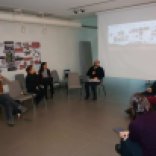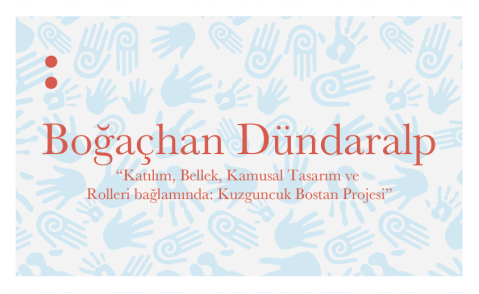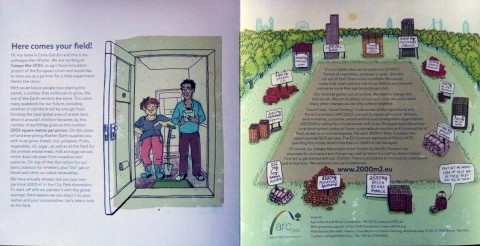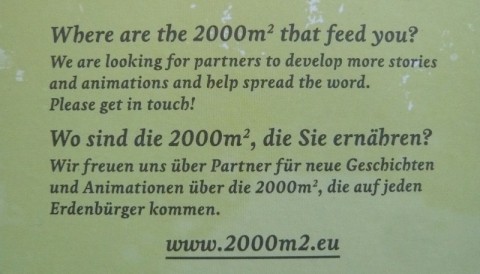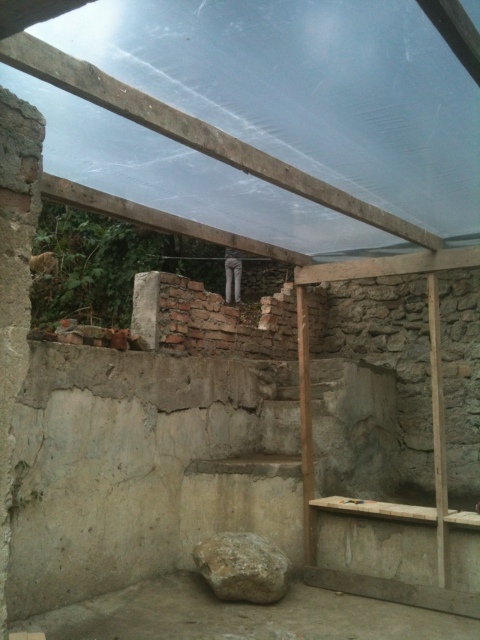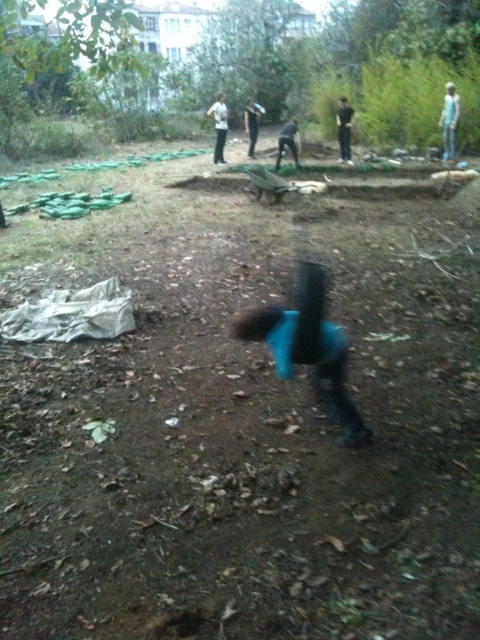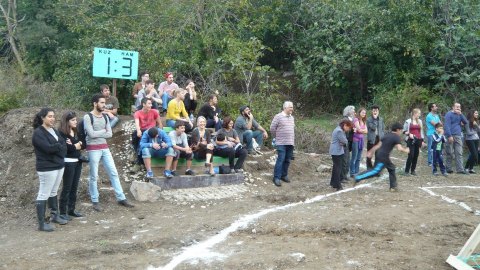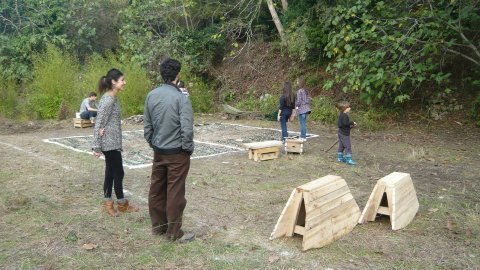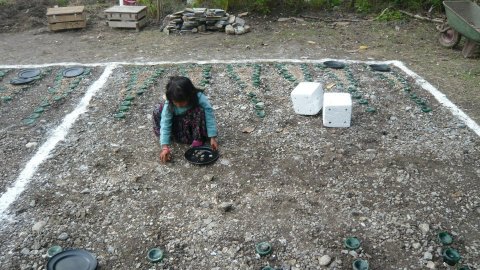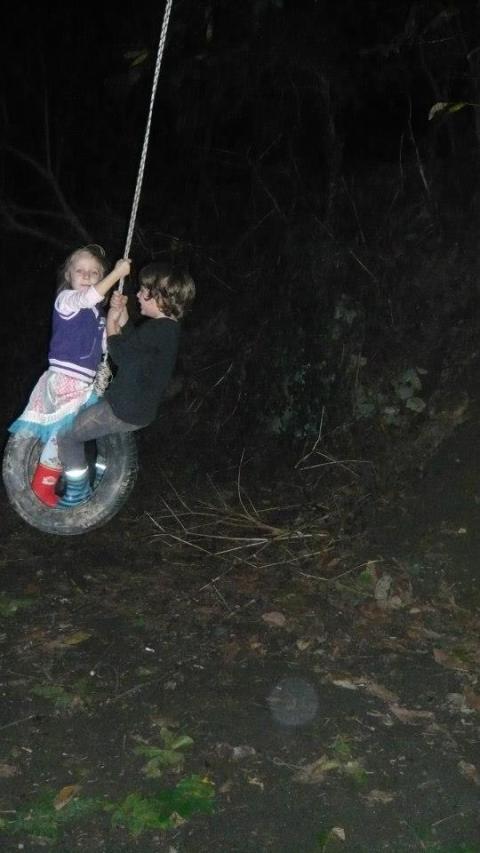2020/02:‘Kuzguncuk Commons: Bostan’ / BAU/ Bahçeşehir Üniversitesi
Şubat 27, 2020 2020/02:‘Kuzguncuk Commons: Bostan’ / BAU/ Bahçeşehir Üniversitesi için yorumlar kapalı

2018/10: Green Commons/ Yeşil Müşterekler // Transmaking (art/culture/economy to democratize society) / Kuzguncuk Bostanı
Ekim 4, 2018 § Yorum bırakın
Gardens, parks agricultural areas and plants are reduced sharply, especially in big cities such as Istanbul, due to expanding constructions and urban settlements although we still need oxygen to live and the agricultural products are still the basic needs of our kitchens. This reduction of green areas and growing air pollution are the important reasons of ruining quality of life due to increasing diseases desperately besides the aesthetic and architectural concerns.
Citizens, civil platforms and academics, still spend their time and energy for more planting separately. As the awareness and interest to the organic life, perm culture and planting is growing within some parts of the community, we are asking whether it is possible or not to combine the energies and interests of different stakeholders who are working on this issue. Through a panel of “Urban Planting as a Public Movement” we would like to gather the parties and search for the answer through a collaborative work for this common purpose. Thus it can likely be possible to take the steps all together to make this way of thinking common within the public to increase planting in the city and strengthen each other through engagement.
Panel Hakkında Detaylı Bilgi almak için tıklayınız.
“Kamusalı Yapmak / Public in the Making” Relais Culture Europe (Paris) tarafından yönetilen, 14 ülkeden 20 kurum ve 150’nin üzerinde bireyin doğrudan parçası olduğu, Horizon 2020 tarafından desteklenen “Trans-making: Art / Culture / Economy to Democratize Society. Research in Placemaking for Alternative Narratives” (https://trans-making.eu/) projesi kapsamında, projenin Türkiye ortakları İstanbul Teknik Üniversitesi ve İzmir Ekonomi Üniversitesi ve BİS tarafından AICA, İstanbul Bilgi Üniversitesi, PASAJ, Karşı Sanat, Mimar Sinan Güzel Sanatlar Üniversitesi, Europist işbirliğiyle düzenleniyor, amberPlatform tarafından koordine ediliyor.
2017/06: Fare Magazine / The Seven Hundred Year Orchard /Kuzguncuk Bostan / City culture through food, history, and community.
Şubat 26, 2018 § Yorum bırakın



Before concrete roads and steam-powered ferries, a green belt lined the Bosphorus, and studded with quaint and colorful villages like Kuzguncuk, it was the rule of coastline life and not the exception. Since the mid-nineteenth century, linkage between the Bosphorus villages and their local megalopolis brought bustle, opportunity, and accessibility, but it also joined their fate to the sprawling mass before them. Many Bosphorus villages underwent major facelifts; transformations and “renewals” brought to their logical extreme through the sort of development schemes that entail wholesale demolition. The regrettable truth is that in present-day Istanbul, these historic villages face a real threat; some vanish completely.
Kuzguncuk is an ancient site along the Asian shores of the Bosphorus. It is shaped by natural borders: the green grove of the Fethi Pasha Woods to the west, and the medieval Nakkaş Baba cemetery to the east. Nowadays it is valued for its two rare features: mahalle culture (the traditional intimate village life and social dynamics of old world Istanbul) and its bostan, or urban garden, a part of an ancient, vast, and highly self-sufficient urban agricultural system.
Today Kuzguncuk’s bostan forms a sizable proportion of its total area, and doubles as a park, meeting space, and communal hub for the village. Amazingly, while many bostans across the city continue to vanish, Kuzguncuk’s garden thrives.
I first visited Kuzguncuk’s bostan with a group of friends one winter morning under a deluge of cold rain. Our timing was poor to say the least, and we’d missed the bulk of the harvest by a month; at that point there were few signs of life in the garden besides the perennial black cabbage. That’s a sharp contrast to the warmer months, when the garden grows more than two-dozen crops including: chili peppers, tomatoes, corn, okra, aubergines, spinach, peas, carrots, and more. We expected the winter garden to be dreary, but the morning of our visit, we were greeted by a troop of school kids who turned a series of large puddles into a splash-park.
The bostan shares a practical and symbolic role in the life of a neighbourhood that battles to maintain its distinction and authenticity. These qualities have long been an attraction to newcomers, notably in the ‘80s and ‘90s, when a generation of artists, architects, and academics moved to the village. Today they share deep-rooted connections to the garden and form the bulwark of its bostan’s defense against redevelopment. “When I was studying architecture 20 years ago,”,says Tülay, a local activist, “I shared a house with some friends across from the bostan. When we came back from school in the evening we would go and pick our tomatoes and aubergines ourselves…”
When Kuzguncuk’s bostan sprang to life several centuries ago, it was one of several hundred urban gardens across the city. Medieval Istanbul made masterful use of its urban greenery through a manipulation of space and a keen understanding of the seasons. Its gardeners organized themselves into guilds, and a whole series of producers and suppliers existed to support the bostans—basket weavers, seed suppliers, and so on. For 700 years the city’s bostans had the incredible wherewithal to support half a million inhabitants with fresh vegetables. Neighbourhoods had specialty crops, like the fragrant strawberries of Arnavutköy, and the small, aromatic cucumbers of Cengelköy. Yedikule’s bostan, the city’s most ancient garden, which still hug the Theodosian Walls, used to produce a soft, almost buttery lettuce.
These are the networks and relationships that lasted into the middle of the twentieth century. New regulations—such as a bill that forbade grazing of livestock— compounded stiff competition from vegetable producers in the Black Sea. These conditions made it extremely difficult to reach a living wage as a gardener. As a result, many if not most bostan owners have opted to sell their land over the last half-century, meaning that most of the city’s bostans have disappeared in the last half-century as owners prefer to sell their land. Many bostans have met particularly ignominious ends, like Arnavutköy, which disappeared under a car wash.
Locals call the Kuzguncuk bostan, “Ilya’s orchard,” citing the now-deceased but much-beloved Greek gardener, the last of an unbroken line to tend the garden’s fields. Greek communities have lived in Kuzguncuk for more than a thousand years: the village’s earliest structure, a Greek Orthodox Church, dates from the 800s. In the 1400s Greeks welcomed the settling of Sephardic Jews, and later Armenians in the 1700s. It wasn’t until the 1950s that a significant Muslim population, including many Turkish migrants from the Black Sea, moved to the village; before then, the few Turks who lived in Kuzguncuk were the Ottoman elite who built their magnificent wooden yalı along its shores. Nowadays the architecture reflects the neighborhood’s intimate and unassuming nature; an Armenian church and Turkish mosque stand close enough as to be practically conjoined, and historic residential areas feature wooden homes limited to just a few stories high, a stark contrast to the city’s concrete districts.
Ilya was the last gardener of his family, but not their last descendant; ownership of the land slipped out of the family amidst rather dubious controversy. In 1964 the Turkish government revoked the right of its Greek populace to permanent residency and local authorities began to exploit this measure as a lucrative source of income generation by seizing properties on the grounds of abandonment. “Ilya’s orchard” was one such property apparently “abandoned” by his family after his death— and sold to a private bidder.
The land was re-sold a few years later, this time to the local Üsküdar municipality, who planned to use most of the bostan’s land for a large primary school. Tülay Atabey and other local architects proposed to the municipality an alternative development plan for the bostan: they focused on repurposing it with a “right to use” rather than a “right to property”, and demonstrated how the bostan could host public events—festivals, outdoor movie screenings, and markets—involve both adults and kids, and, through the use of raised growing beds, even offer access to gardeners with disabilities as well.
The local community mobilized to show support for the alternative bostan project across media channels and through festivals, workshops, and widespread demonstrations. Across the city, the bostan became a symbol for the larger battle against expansive urban renewals. Tan Morgül, another prominent member of this collective, ushered its rallying cry: “the Kuzguncuk Bostan is Kuzguncuk’s memory, its breath, its colour! Let’s not allow anyone to touch our history, our breath or our green!” The locals boast that the campaign was the most significant protest until Gezi Park in 2013.
Üsküdar’s primary school plans were ultimately shelved, to great relief, in favor of the alternative bostan project. Now, since 2010, locals have been able to develop the land in ways that suit the community; also leading to a sharp rise in activity. There is now so much demand for the garden’s 100 allotments that they must be decided by annual lottery.
///
While my friends and I only saw the bostan in the winter, it was clear how it actively works for the community throughout the year: in the spring and summer evenings it hosts outdoor movie screenings and theater performances, and experts travel from different universities across Turkey to lead workshops. During the festive nights of Ramadan, locals break their fast together outdoors. In autumn, the neighbourhood communes to celebrate the harvest, teaching local kids about a range of produce. On the weekends, the streets spill out into a market bazaar. From the windows and balconies of nearby houses, the people of Kuzguncuk can hear nightingales sing into the early hours of morning.
After leaving the bostan, we were toured down Kuzguncuk’s main street by locals Tülay Atabey, Boğaçhan Dündaralp, and Aylin Örnek. We were taken to a local café, Kuzguncuk Pita, owned by Aylin. Tea was quick to emerge, along with plates of different sweet and savory pastries from the home-style kitchen. A full range of soft sheep’s milk cheeses were stacked behind tall glass counters at the corner of the kitchen. Through the café’s wide windows it was hard to ignore how the hanging greens of the ambling trees, the settled and slow pace of passerby, coffee-drinkers, and cats alike lent this area a peace worlds’ apart from the speed and relative chaos of some of the city’s other neighbourhoods. This, I thought, was the beauty of Kuzguncuk, this unexpected bastion of village life.


2017/01: Kuzguncuk Bostanı / Dayanışma Mimarlığı Sergisi ve Kitabı / Mimarlar Odası İstanbul Büyükkent Şubesi
Mayıs 19, 2017 § Yorum bırakın
2016/1: All issues and problems can become objects of design process / Public Design Support 2011-2016 / Jesko Fezer & Studio Experimentelles Design / Kuzguncuk Bostan
Şubat 20, 2016 § Yorum bırakın
Public Design Support Workshop / Boğaçhan Dündaralp, Architekt
The best scenario for Kuzguncuks future is to increase the possibilities for sharing and to keep it alive – a scenario, which would highlight the importance and value of the orchard for Kuzguncuk. One of the most important contributions during this process, was the “Public Design Support Workshop” realized by Jesko Fezer and his students at the 1st Istanbul Design Biennial 2012. During this weeklong period, we experienced a cohesive and motivating project around a series of ad-hoc interventions that turned into a weekend event in the orchard. Simple arrangements like playgrounds (a football field, a grandstand, a swing, backgammon), tea garden and a picnic ground produced catalysing sensations that evocated curiosity. While Meric Kara from Bilgi University and the students at Kuzguncuk Primary School were directly involved in this event, local architects, Kuzguncuk residents and neighbourhood administrator (muhtar) provided support.
Collective production contains a unique temporality, knowledge production and dissemination processes. This work is invaluable since it shows us the fact that physical encounters and rapprochements that aim at direct production, trust that emerges from common experience and collaboration, common negotiations and sensations provide an opportunity for a unique kind of knowledge production, dissemination and sharing. We experienced a process that revealed the value of keeping the sensations that emerge from social and environmental needs and threats alive in our daily lives. As much as experiencing and being educated by these contexts and sentiments, we have to create mutual experiences and remember that they are a very important source in terms of producing social and democratic contexts through common decision and negotiation processes.
As an architect that tries to resist contemporary trends that limit the role of the designer to mere “aestheticization” of her environment, and as a Kuzguncuk resident, I want to thank Jesko Frezer and his students, Adhocracy exhibition curator Joseph Grima, and the associate curator Pelin Tan, who helped us carry this project to Kuzguncuk, and all others who participated and contributed in this process and helped us produce and keep this experience alive. / 2012
* An addendum for the book, added after 3 years:
Kuzguncuk residents and the Association of Kuzguncuk Residents worked devotedly to overcome once again in their 20-year-old struggle against development threat on the Orchard of Kuzguncuk, and in 2013 they did manage to cancel out development plans for a school on the orchard area. In 2014 the orchard has been leased out to the Uskudar Municipality as a result of a tender which was put out by the General Directorate for Foundations. The alternative project that we prepared collectively with the residents of the neighborhood in 2010 suggests shared public use of the orchard, and it was brought back to the agenda as the orchard gets a new tenant. The project has put into practice through a collaboration between the association, the residents of neighborhood and the municipality while we, as architects from Kuzguncuk, moderate the process. The orchard life that we looked forward to through this project initiative for last 5 years of 20-year-old resistance struggle has become more than just a conservation of land, and nowadays the orchard keeps creating new uses and new characteristics to its collective memory. Until the next possible attack for future development plans on the Orchard Kuzguncuk residents look happy and the neighborhood is in high spirits.
2015/12: Katılım, Bellek, Kamusal Tasarım ve Rolleri bağlamında Kuzguncuk Bostan Projesi / Çarşamba Seminerleri / Mimar Sinan Güzel Sanatlar Üniversitesi
Aralık 21, 2015 § Yorum bırakın
“Kentli olma haklarının ihlal edildiği,birbirinden izole edilmiş, tüketim odaklı, yapay ve homojen peyzaj fragmanlarına dönüşmeye başlayan bir kentiçin kuşkusuz en çarpıcı sonuç, kentlerde alternatif yaşam ve özgürleşme olanaklarının giderek yok edilmesidir. ‘Yer’ duygusunun hissedilebildiği,kendine göre bir hayat ritmi, yaşama biçimi olan, katmanlı, üretken kent peyzajlarının tıpkı kentin doğal kaynakları gibi kaynaklarından kopartılması,yok edilmesi giderek artmaktadır. Kentler kendi kültürel birikimini doğurduğu devinim ve zenginliklerini, etkileşime dayalı ağları ve üretkenliklerini kaybetmektedir. Sosyal ve ekolojik krizlerin kaynağı haline gelen bu ortamda ‘tasarım’, ‘yer’in kendi gerçekliğini yok sayan, yoğun estetizasyon ve yeniden işlevlendirmeyle olageleni meşru kılan bir araç gibi; ‘tasarımcı’ da yaratıcılığı bu yönde teşvik edilen pasif ve uzlaşmacı bir rolde kullanılmaktadır. Kuzguncuk Bostanı’nın hikayesi böyle bir ortamdaki direniş mücadelesidir. Bu hegemonik kent peyzajı üretiminde gücünü ‘yer’ den alan kendi kültürel ve sosyal birikimini kullanarak; kendinin ve kentinin doğal kaynaklarından biri olan ‘bostan’ını korumaya çalışanKuzguncukluların hikayesi…”
2015/08: 2000 m2 / kuzguncuk bostan / istanbul
Ağustos 26, 2015 § 1 Yorum
Bostan: 2000 m² in Istanbul, Turkey
In Istanbul the community garden project Bostan is awaken to a new life. The word Bostan means garden near your house, where you grow your daily food. And this is what people like to do in Turkey, even when they live in a city of millions – like Istanbul. For more than 30 years people people here have struggled to defend their common garden against urbanisation. Since 2015 people can produce their food at Bostan, School gardens and fruit trees included.
Continue reading here: http://www.2000m2.eu/tag/istanbul/
kuzguncuk bostan & public activities
http://www.2000m2.eu/tag/istanbul/
http://www.2000m2.eu/bostan-a-garden-near-your-house-in-istanbul/
2012/11: Kamusal Destekli Tasarım Atölyesi / Deneysel Tasarım Stüdyosu, HFBK Hamburg /Adhokrasi, İstanbul Tasarım Bienali
Aralık 4, 2012 § 1 Yorum
Public Design Support Kuzguncuk, Studio for Experimental Design HFBK Hamburg, Adhocracy, Istanbul Design Biennial
Kuzguncuk: Bostan; Kamusal Destekli Tasarım;Workshop
*İstanbul_Kuzguncuk
Kuzguncuk; İstanbul’ un yoğun yapılaşma, sürekli ve hızlı dönüşüm trafiğinden ya da son dönemlerdeki kentsel dönüşüm adı altında yapılan tepeden inme ‘gentrification’ ya da soylulaştırma’, ‘yerinden etme’, ‘değer arttırma’ gibi kentsel operasyonlardan kendini koruyabilmiş, ‘yavaş’ dönüşüm yaşayan, otantik varoluşunu, dokusunu, karakterini koruyarak gelişen, Istanbul’ da kalan belki de tek boğaz köyü. “Bunu nasıl başarıyor?” sorusunu sorarsak, bunun iki tane temel yanıtı var. Birincisi İstanbul’ daki topoğrafik konumu: bir yanda Fethipaşa korusu, diğer yanda Nakkaşbaba mezarlığı arasında bir vadiye yerleşen köy, Bağlarbaşı tarafında arka uçtaki kentsel gelişmeden kısmen kendini topoğrafik sınırlarla yalıtabilmiştir. Bu sınırlar içindeki fiziksel-karakteristik dokusu ‘sit alanı’ kapsamında da korununca; yıkılmadan yenilenerek varolmayı zorunlu kılan alçak katlı, eski eser ağırlıklı bir doku olarak konumunu sürdürebiliyor. İkincisi bu doku sayesinde 1980’lerden başlayarak ciddi bir entelektüel göç alarak buradaki doku hem yenileniyor hem de yaşayanlar anlamında yeni komşuluk ilişkileri üretiyor. Bu entelektüel göç, gün geçtikçe artmasına rağmen hızlı bir dönüşümle değil; müzakere, karşılaşma, kabullenme, karşılıklı birbirinin varlığını kabul ederek ilerleyen bir süreçle gerçekleşiyor. Bu nedenle neo-liberal ekonomilerle üretilen hızlı kentsel dönüşümlerde olduğu gibi alt-ekonomiyi, ekonomik dengesizlikleri, komşuluk ilişkilerini ortadan kaldıran, bölgeler arası ekonomik göstergeleri uçlara taşıyan ayrışmalar burada gözlemlenmiyor. Onun bu koşullarda İstanbul gibi hızlı dönüşümün yaşandığı bir kentte kendi kimliğini koruyarak ağır evrimleşmesi; bir taraftan kentleşme ile kaybedilen pek çok olgunun hala varolabildiği bir yaşam alanını temsil etmesini sağlıyor, diğer taraftan da onun bu kimliğini gözler önüne sunan Tv dizileri, reklamlar, sayesinde de bir turistik cazibe merkezi haline geliyor.
*Kuzguncuk_Bostan
Bostan ise bu kentsel doku içinde kalan, son yeşil boşluk olarak hem yerel yönetimler, hem de ekonomik iktidarların İstanbul’un hızlı kentsel dönüşümünün Kuzguncuk’ taki anahtarı olarak her 10 yılda bir gündeme taşınıyor. Bostan olarak korunması gerekli bu alan; İmar Planlarında 1980’lerin ikinci yarısında yapılan oynamalar sonucu bunlara karşı açılan davalar gibi hukuki düzlemlerde de verilen savaşlarla, 1990’ da ve 2000’ de buradaki bilinçli yerel oluşumlar sayesinde korunabilmiş ve 2010’da tekrar bu alan üzerindeki planlar gündeme gelmiştir. Mülkiyet hakkını elinde tutan Vakıflar Genel Müdürlüğü tarafından bu alana bir proje hazırlatılarak, hayata geçmesi için bir girişimde bulunulmuştur.
*BostanA Alternatif Proje Girişimi
BostanA Alternatif Proje Girişimi ise, bu projeye alternatif olarak, alanın hem kullanımını hem de kullanım potansiyellerini alanın karakteri bozulmadan nasıl sürdürebileceğini göstermek amacı ile başlatılmıştır. Katılımcı bir süreçle geliştirilmeye başlanan bu çalışma, bir taraftan Bostan’ ın süregiden yaşantısını katılımlarla zenginleştirerek teorik bir egzersizden çok, pratik uygulamaya dair yeni üretim olanaklarını ve ekonomi modellerini ortaya koymaya çalışmaktadır. Kent platformunda, kimliğini koruyarak açığa çıkaracağı kamusal kullanımlarla hem Kuzguncuk’ a hem de İstanbul’ a yeni kentsel kullanımlar sunabilecek; ortaya koyduğu ekonomik model ile bir kent parçasının ‘değer’ ine ilişkin yeni bir öneri sunabilecektir. Mimarların sosyal bir aktör (katalizör) ve mimarlığın bir iletişim aracı olduğu bu çalışma ile; alternatif olunan projenin hem yapısal durumuna hem de kentteki bir alanın ‘değer’ine ilişkin bugünün kent politikaları, kentleşme modelleri üzerinden yeni bir müzakere alanı açılarak, bu alana ilişkin yaklaşımların ‘tek bir model’ üzerinden yapılamayacağı gösterilmeye çalışılmaktadır. ‘Mülkiyet hakkı’ ndan çok ‘kullanım hakkı’ na odaklanan bu çalışma, tarafları yeni bir müzakere alanına taşıyarak, Bostan’ ın sahip olduğu değerleri kaybetmeden yaşatılabileceği alternatif modeller üretmeye zorlayabilirse görevini başarı ile yapabilmiş olacaktır.
Süreç:
Bu çaba ile Kuzguncuk ittifakı, Bostan’ ın sahip olduğu değerleri kaybetmeden yaşatılabileceği alternatif modellerin de mümkün olabileceğini ve bu yönde ortak bir çaba içine girebileceklerini gösterdi. Tüm proje onay süreçlerini takip ederek, kurumlarla iletişimini kaybetmeden sürekli tetikte ve proje ile ilgili gelişmeleri izledi. 28.06.2012’de Kültür Ve Turizm Bakanlığı, İstanbul 6 Numaralı Kültür Varlıklarını Koruma Bölge Kurulu, Kuzguncuk bostanında yapılmak istenen özel ilköğretim tesis alanı yapılaşma başvurusunu; programı ve yapı kütlesi nedeni ile Kuzguncuk mimari dokusuna uyumlu olmaması gerekçesiyle uygun olmadığına, ayrıca parsel içinde tespit edilen bostan havuzunun korunması gerekli kültür varlığı olarak tescil edilerek koruma grubunun 2.grup olarak belirlenmesine karar verdi.
Kuzguncuklular bu kararla biraz nefes aldılar, zaman kazandılar ancak süreç de direniş de bitmiş değil…
Kamusal Destekli Tasarım Atölyesi:
Bundan sonraki süreçte bostanın Kuzguncuk için önemini ve değerini görünür kılacak en iyi durum; buranın yaşamaya devam etmesi ve Kuzguncuklular’ın bu alan içindeki paylaşımlarının olanaklarının artması olacaktır.
Bu süreçteki en değerli katkılardan biri:
Hamburg Güzel Sanatlar Üniversitesinde Deneysel Tasarım profesörü ve adhokrasi sergisi tasarımcısı Jesko Fezer ve öğrencilerinin 30 Ekim-3 Kasım 2012’de 1. İstanbul Tasarım Bienali çerçevesinde gerçekleştirdikleri “Kamusal Destekli Tasarım Atölyesi” olmuştur.
Bu bir haftalık süreç içinde, Bostanda bir hafta sonu etkinliğine dönüşecek bir dizi geçici müdahalenin üretildiği; birleştirici ve motive edici bir çalışma deneyimledik. Oyun alanları (futbol alanı, tribün, salıncak, tavla), çay ocağı, piknik alanı… gibi basit düzenlemeler ardında tetikleyici ve merak uyandırıcı pek çok duygulanımı peşinden üretti. Bilgi Üniversitesi Tasarım Bölümünden Meriç Kara ve öğrencileri, Kuzguncuk İlkokulu öğrencileri bu çalışmalara doğrudan katkı üretirken; yerel mimarlar, Kuzguncuklular ve Kuzguncuk Muhtarı bu çalışmalara destek verdiler.
Kollektif üretimlerin kendilerine ait zamansallığı, bilgi üretimi ve yayılımı vardır. Bu çalışma; doğrudan yapmaya yönelik fiziksel karşılaşma ve yakınlaşma, ortak deneyim ve işbirliğinin yarattığı güven ile ‘ortak müzakerelerin’ , ‘ortak duygulalanımlar’ın başka hiçbir şeyin sağlamadığı kendine özgü bilgi üretimi ve yayma, paylaşma imkanı olduğunu bize yeniden göstermesi anlamında çok kıymetli.
Bu süreçte ancak toplumsal, çevresel ihtiyaç ve tehlike söz konusu olduğunda ortaya çıkan duygulanımların ve çabaların; gündelik hayat içinde sürdürülebilmesinin önemini açığa çıkartan bir deneyim yaşadık. Bu ortamların ortak duygulanımların eğitimi, deneyimi kadar karşılıklı olarak deneyim yaratmak,ortak karar ve müzakere süreçleri yoluyla toplumsal ve demokratik ortamlar üretme açısından da ne denli önemli bir kaynak olduğunu da unutmamak lazım.
Tasarımcıyı içinde bulunduğu ortamı ‘estetize’ etmekten başka bir çare ya da rol bırakmayan güncel eğilimlerin karşısında durmaya çalışan bir mimar olarak, bir ‘Kuzguncuklu’ olarak; kendi mücadelemiz içinde bu deneyimi üretme ve yaşama imkanı sağlayan başta Jesko Fezer ve öğrencilerine, Adhokrasi sergisi küratörü Joseph Grima’ya, çalışmayı Kuzguncuk’a taşımamızı sağlayan yardımcı küratör Pelin Tan’a, bu süreçte yer alan ve katkı sağlayan herkese çok teşekkür ederiz.
Boğaçhan Dündaralp
Kuzguncuk: Bostan; Public-supported Design; Workshop
*Istanbul_Kuzguncuk
Kuzguncuk is perhaps Istanbul’s sole village to have survived along the Bosphorus. It has succeeded in defending itself against the intensive rise in construction, the rapid transformation in traffic and various urbanistic operations choking thecity. These urbanistic operations, are conducted under the motto of “urban transformation” to impose gentrification in various parts of Istanbul at the cost of displacing former inhabitants and for the sake of so-called “added value”. Kuzguncuk has been able to keep itself astride from all this, experiencing its own slow transformation and evolving within its own authentic life style, maintaining its fabric and character. “How does it do it?” one might ask. There are two basic answers to this question. The first has to do with its topographical situation in Istanbul: Kuzguncuk is a village nestled in a valley which is bordered by the Fethi Pasha Woods on one side and the Nakkashbaba cemetery on the other. It has been able to protect itself from the concrete jungle of the Baglarbasi disrict to its east, thanks to its own topographical borders. Having been declared a protected site, its physical and characteristic fabric within these borders has aslo been preserved. Its fabric is composed mainly of ancient buildings, not more than a few storeys high, which cannot be pulled down and have to be renovated. Secondly, thanks to this fabric, Kuzguncuk became prized by intellectuals who began settling there from the 1980s on. This led to the renewing of the existing fabric and to new neighbourly relations. This intellectual immigration, increasing day by day, has not however led to a rapid transformation but is rather evolving in a process of negotiation, encounter, acceptance of one another between the old and new inhabitants. This is why the economic imbalances, the disappearance of neighbourly relations, the extreme disparity in economic indicators between regions, all characteristic of rapid urban transformation projects developed by neo-liberal economies, are not to be found here. Evolving at its own pace while maintaining its identity in an Istanbul undergoing rapid change, allows Kuzguncuk to flag up a life style which has been sacrificed to urbanisation elsewhere. This very setting, found so attractive by TV serials and advertisements, also adds to its becoming a centre of attraction for tourism.
*Kuzguncuk_Bostan
Bostan, the kitchen garden,being the lastpatch of vacant green in the midst of this urban fabric is coveted every ten years by both local administrations and economy magnates as the key to Kuzguncuk’s rapid urban transformation. This land which needs to be protected as a kitchengarden, had been subject to assault by tampering on the city’s Master Plan in the late 1980s. This assault was countered by a legal struggle launched by the conscientious locals who succeeded in gaining the law suits they brought against two such attempts in 1990 and 2000. In 2010 this coveted piece of land was once again threatened by a new attempt .The Directorate General for Foundations, who is at present in possesion of the title deed for this property, commissioned a project* and has made a move to implement it.
*Alternative Project Initiative BostanA
The Alternative Project Initiative BostanA was launched as an alternative to the previous project with the aim of showing how the Bostan can be potentially used and sustained without harming its original character. Encouraging a participatory perspective from the onset, the alternative project is less a the oretical exercise than an attempt to diversify and enrich the Bostan’s present life through practical measures allowing for new modes of production and economic models. The Project proposes to reveal how a given space can be put to public use while preserving its identity at the urban level, how it can offer new urbanistic uses not only to Kuzguncuk but to Istanbul at large. With the economic model it proposes, the Project also puts forward a new perspective on the “value” of an urban space. Bearing in mind that architects are social actors and that architecture is a mode of communication, the Project aims to open a new debate on existing urban policies and urbanisation models by contesting the structural aspects of the previous projects as well as the “value” attributed to a space in the city. In so doing, the Project attempts to show that a “single model” approach cannot be imposed on this space.
Focusing on the “right to use” rather than the “right to property”, the Project will deem itself successful if it contributes to drawing the concerned parties to a new platform for negotiation and instigates the development of alternative models allowing the Bostan to maintain its existence without losing its values.
Public-Support Design Workshop:
The best scenario for Kuzguncuk, in the future, is to increase the possibilities for sharing in this neighbourhood and to keep it alive – a scenario, which would highlight the importance and value of the orchard for Kuzguncuk.
One 0f the most important contributions, during this process, was:
The “Public-supported Design Workshop” realized by Jesko Fezer (a professor of Experimental Design at Hamburg University of Fine Arts and a designer at the adhocracy exhibition) and his students at the 1st Istanbul Design Biennial between 30 October and 3 November 2012.
During this weeklong period, we experienced a cohesive and motivating project around a series of ad-hoc interventions that turned into a weekend event in the orchard. Simple arrangements like playgrounds (a football field, a grandstand, a swing, backgammon), tea garden and a picnic ground produced catalysing sensations that evocated curiosity. While Meric Kara from Bilgi University Department of Design and his students and the students at Kuzguncuk Primary School were directly involved in this event, local architects, Kuzguncuk residents and neighbourhood administrator (muhtar) provided support.
Collective production contains a unique temporality, knowledge production and dissemination processes. This work is invaluable since it shows us the fact that physical encounters and rapprochements that aim at direct production, trust that emerges from common experience and collaboration, “common negotiations” and “common sensations” provide an opportunity for a unique kind of knowledge production, dissemination and sharing.
In this process, we experienced a process that revealed the value of keeping the sensations that emerge from social and environmental needs and threats alive in our daily lives. As much as experiencing and being educated by these contexts and sentiments, we have to create mutual experiences and remember the fact that they are a very important source in terms of producing social and democratic contexts through common decision and negotiation processes.
As an architect that tries to resist contemporary trends that limit the role of the designer to a mere “aestheticization” of her environment, and as a Kuzguncuk resident, I want to thank Jesko Frezer and his students, Adhocracy exhibition curator Joseph Grima, and the associate curator Pelin Tan, who helped us carry this project to Kuzguncuk, and all others who participated and contributed in this process and helped us produce and keep this experience alive.
Boğaçhan Dündaralp
2011/03: bostana alternatif proje girişimi
Ağustos 1, 2011 § Yorum bırakın
2011/05: 17. taşkışla bahar şenliği / kuzguncuk bostanı fanzin atölyesi
Ağustos 1, 2011 § Yorum bırakın
atölye organizasyon: seda tuğutlu, oğuzhan saygı, elif gökçen tepekaya, begüm moralıoğlu, selin uğur, sunay paşaoğlu, figen inam, yılmaz taha sezgin, fatih kesekçi
pafta no* // katılımcılar:
P1 // arda bakıryol_birinci sınıf
türker naci şaylan_birinci sınıf
P2 // ahmet arif aksoy_ikinci sınıf
P3 // ayşe dede_üçüncü sınıf
P4 // ayşegül çakan_ikinci sınıf
P5 // seda tuğutlu_birinci sınıf
burak öztürk_ikinci sınıf
P6 // ceren okumuş_ikinci sınıf
P7 // dilara dağlı_ikinci sınıf
ayşe kahraman_ikinci sınıf
fulya doğru_ikinci sınıf
P8 // sunay paşaoğlu_birinci sınıf
elif gökçe tepekaya_birinci sınıf
P9 // yılmaz taha sezgin_birinci sınıf
selin uğur_birinci sınıf
* paftalar/fikirler için bkz. fanzin
davetli tartışmacılar: boğaçhan dündaralp, lale ceylan
“Boğaçhan Dündaralp ile fanzin atölyesi fikri, dokuz birinci sınıf öğrencisinin Kuzguncuk Bostanı hakkında düşünmesi, heyecan duymasıyla başladı. Atölyenin ilk ayağı bu dokuz öğrenciyle bostanda gerçekleşti. 1 Mayıs Pazar günü bostanın alternatif kullanımlarını çoğaltmak, geliştirmek fikriyle bostanda bir yerleştirme yapıldı. Yapılan yerleştirmenin çıktıları değerlendirilip, bu sefer 17. Taşkışla Şenliği’ nde on beş katılımcıyla bostanın var olan potansiyellerini ortaya çıkartmak, çoğaltmak, tartışmak için fanzin atölyesi düzenlendi. Bu atölyenin çıktısı olarak üretilen fanzin Taşkışla Şenliklerinde okula dağıtıldı.” – arkitera.com
_ atölyede üretilen tüm fikirleri fanzinden okumak için tıklayınız.
_ http://kuzguncukworkshop.tumblr.com/
+
_ etkinlik haberi için tıklayınız/arkitera.com
_ şenlik anasayfası ve programlar hakkında detaylı bilgi için tıklayınız.

“kuzguncuk bostanına alternatif fikirler” fanzini is licensed under a Creative Commons Attribution-NoDerivs 3.0 Unported License.























